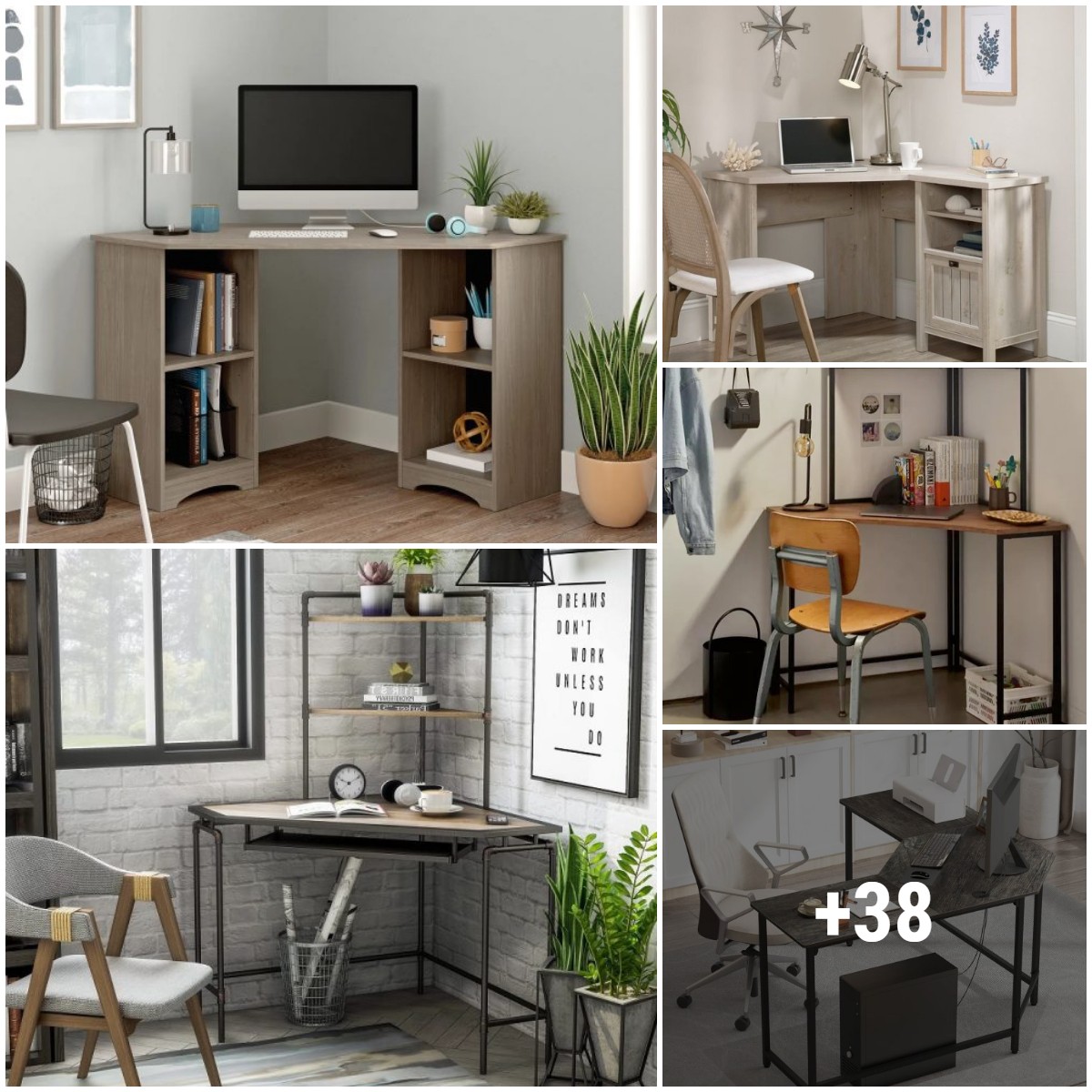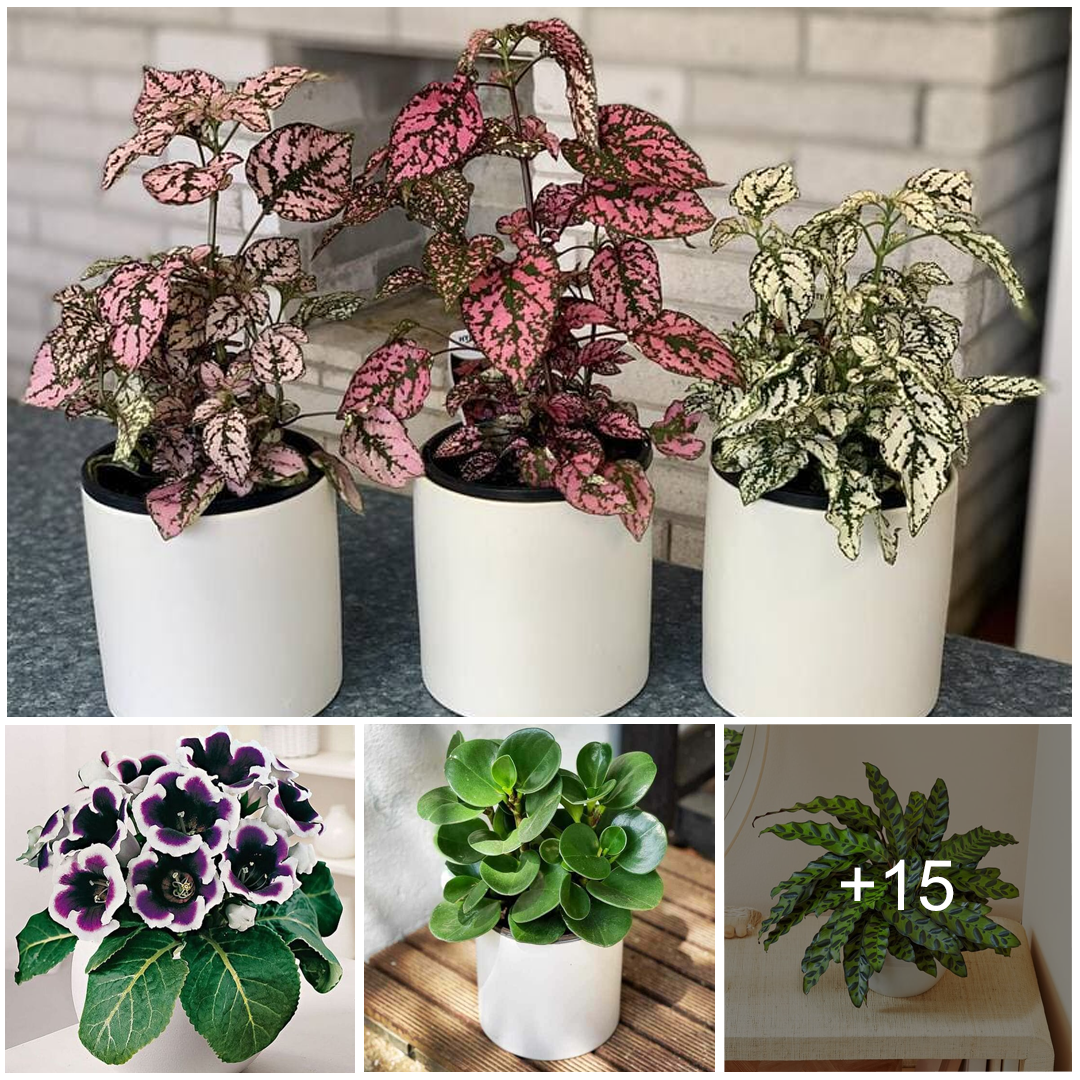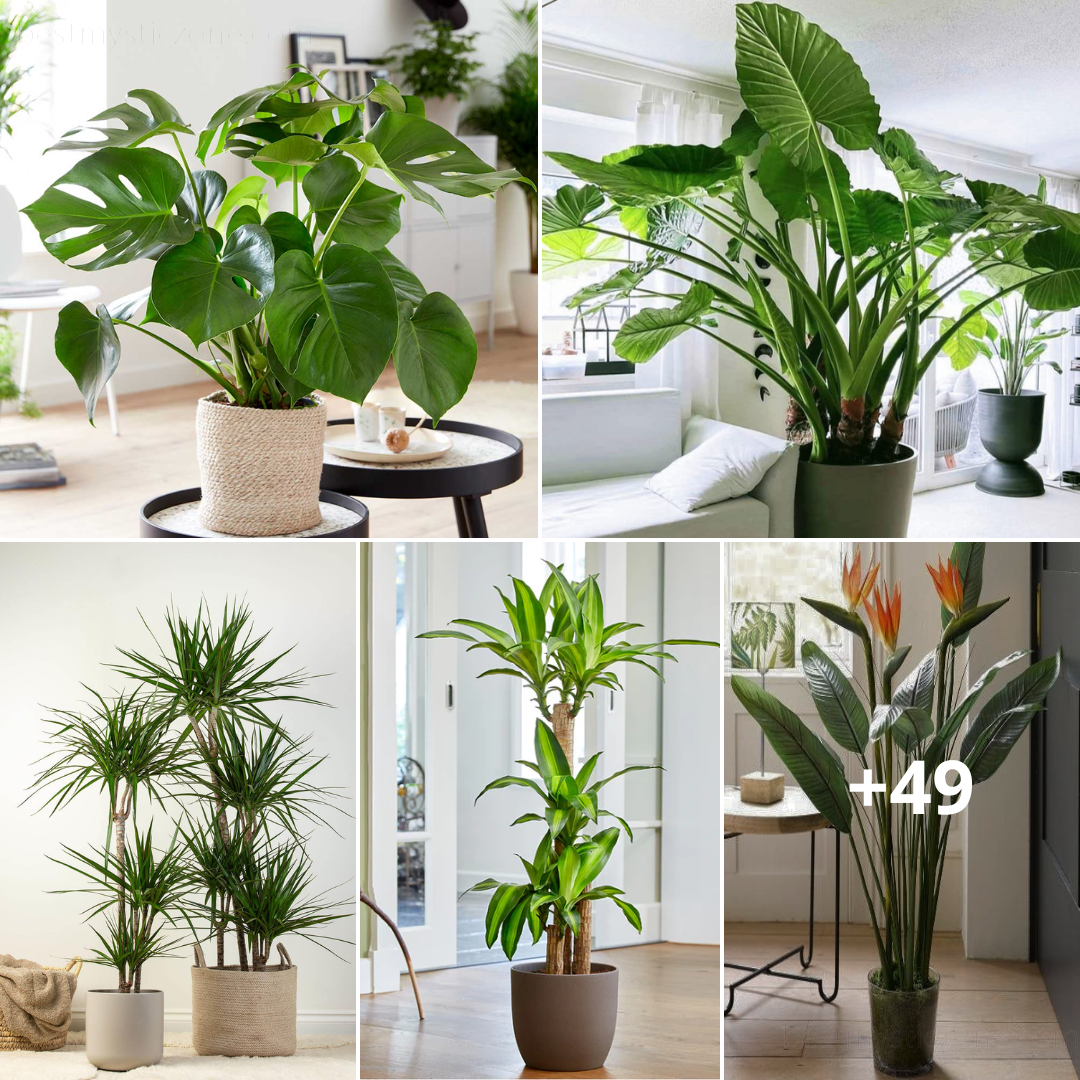Ficus trees are some of the most popular plants for growing indoors as houseplants. Each variety produces attractive foliage and unique silhouettes that can truly make them a delight to cultivate in your home. Keep reading to learn all about the best types of ficus trees and some of the most popular species for growing as houseplants.
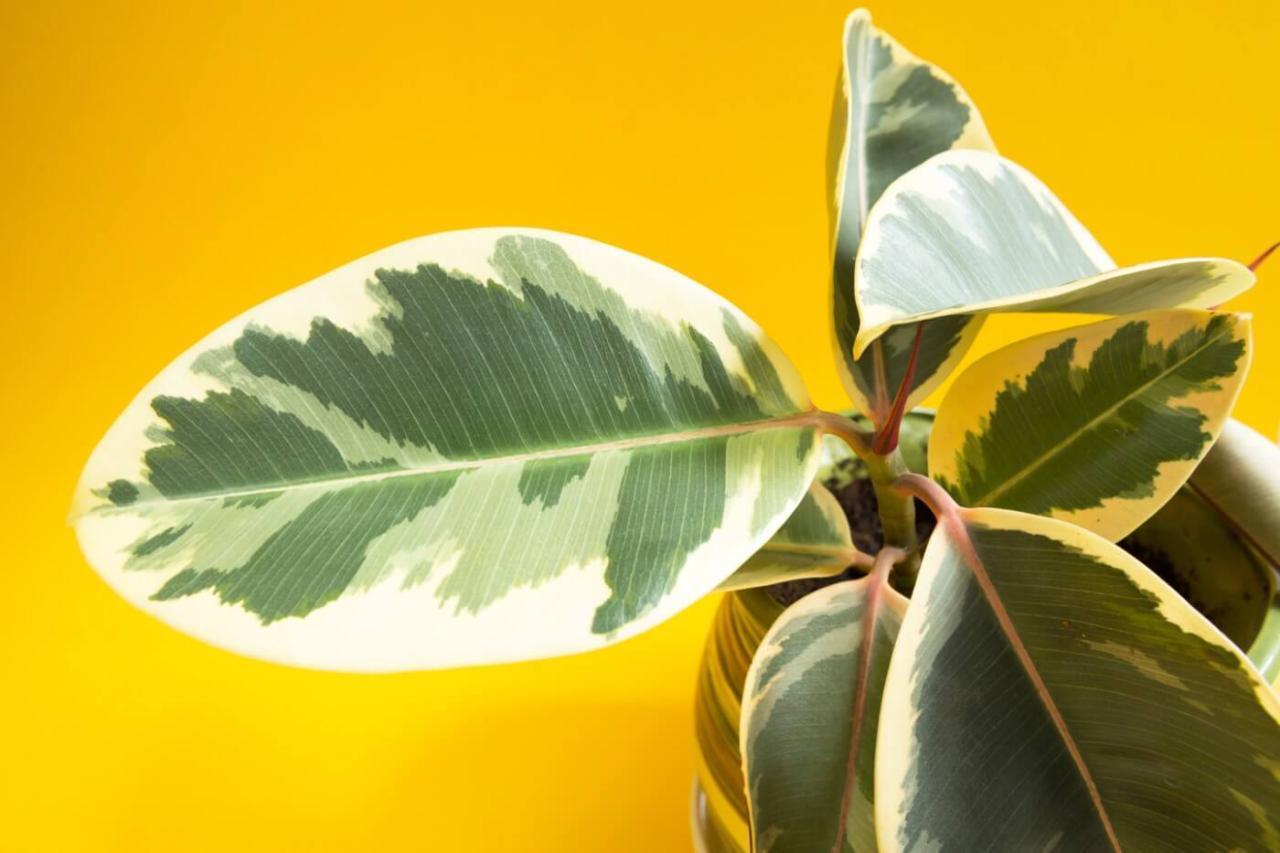
About Ficus Trees
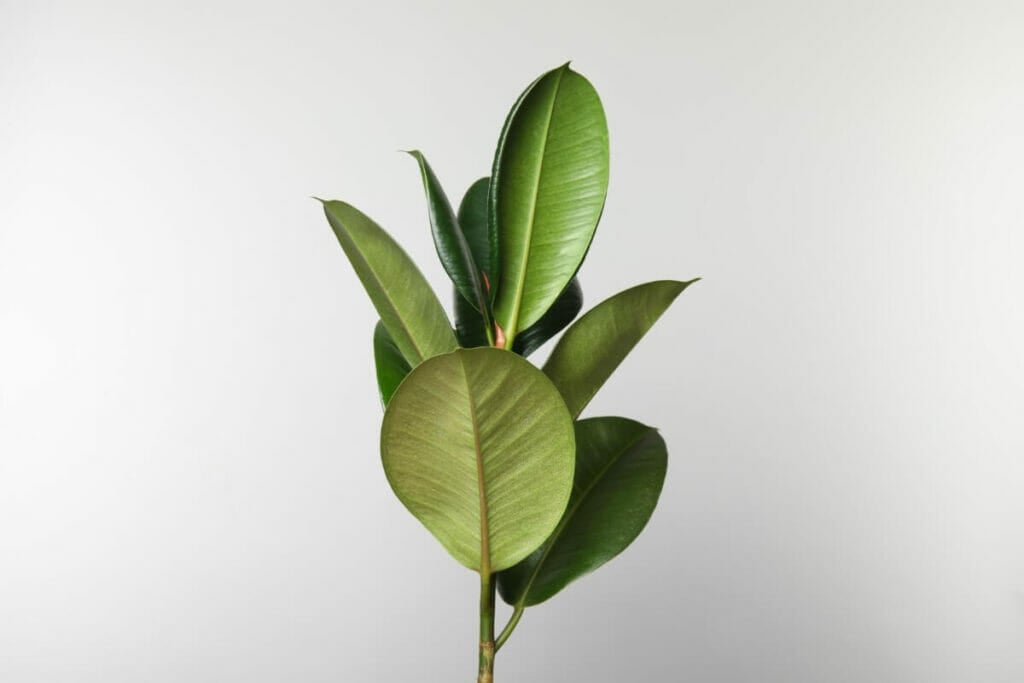
Native to tropical regions all around the world, the Ficus plant genus contains about 850 species of trees, vines, shrubs, epiphytes, and hemiepiphytes that belong to the Moraceae plant family. Collectively, this group of plants is known commonly as figs, fig trees, or ficuses, although specific species have their own common names as well.
Uses and Benefits of Ficus Trees
When kept as houseplants, ficus trees are primarily considered to be ornamental plants. However, these tropical plants don’t just sit around and look pretty; they have many additional benefits to offer.
For example, the species, Ficus carica (common fig), is widely cultivated for its sweet fruit.
NASA’s clean air study looked at the air-purification properties of both Ficus elastica and Ficus benjamina. The study found that they are both excellent air-purifying plants. Both species remove toxins (such as formaldehyde, xylene, and toluene) from the air while also helping to replenish oxygen.
Ficus trees are also considered to be lucky or auspicious plants in feng shui practices. In feng shui, ficus trees are said to draw positive energy, help neutralize negative energy, and can also draw abundance and wealth. Ficus plants possess these positive attributes due to the fact that they are fruit-bearing and have leaves that are typically round or ovate, glossy, soft, and pliable, so they can flutter in the wind.
Ficus trees have had many other uses and benefits worldwide and throughout history. The latex sap of some ficus trees has been used to produce rubber. They have also been used in herbalism and to make papers, textiles, elements of architecture, and were even used to construct caskets for mummies in ancient Egypt.
Ficus Tree Meaning and Symbolism
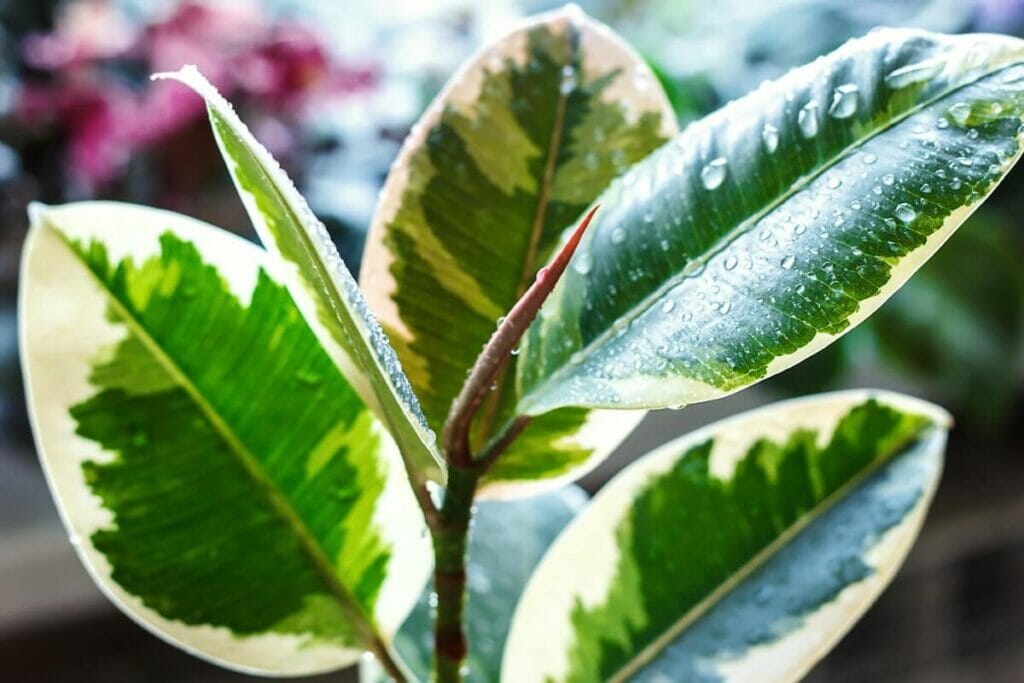
Ficus trees symbolize peace and abundance. They also hold special spiritual significance in many religious traditions.
Ficus and fig trees have a place or are mentioned in several religions around the world. They appear in Buddhism as the Buddha is said to have achieved enlightenment while meditating under a fig tree. Fig trees also appear in the Torah and both the Old and New Testaments of the Bible. It’s also a significant tree in Islam, Hinduism, and Jainism.
17 Popular Types of Ficus Trees
1. Fiddle Leaf Fig (Ficus lyrata)
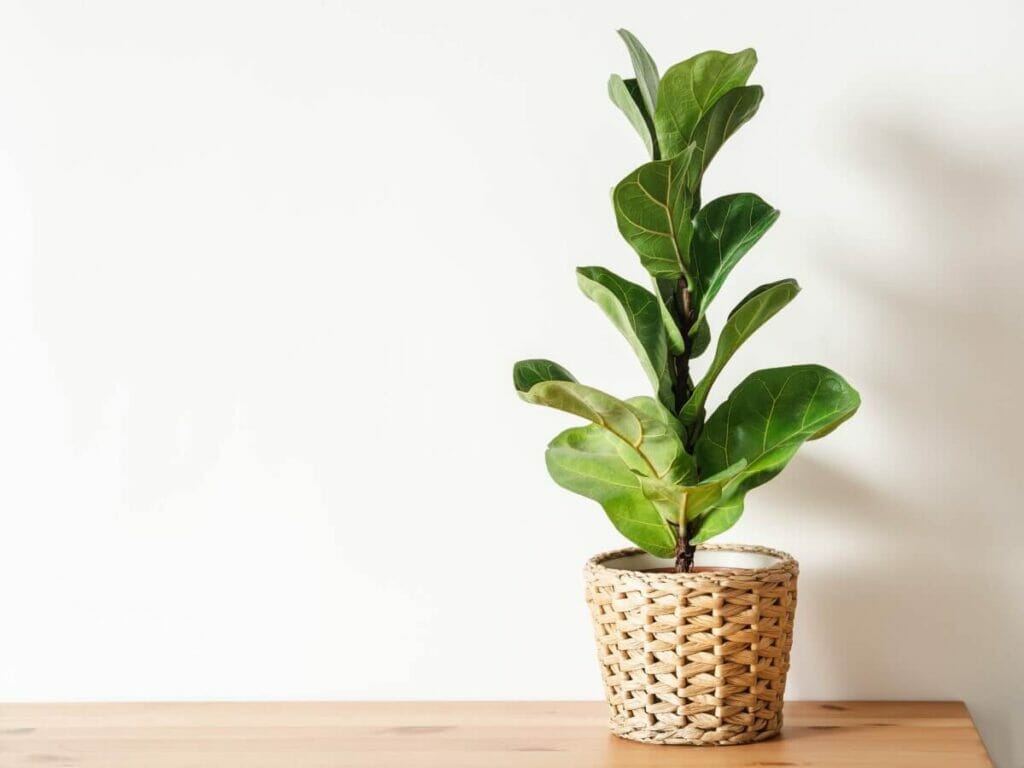
The fiddle leaf fig might be the most popular type of ficus to grow indoors. These trees have lovely, slender, brown trunks and broad, glossy leaves that are shaped similarly to fiddles, growing broader at their bases and tips. Native to western Africa, fiddle leaf fig trees can grow to be about 50-feet tall in their natural habitat. Indoors, they can grow to be about 10-feet tall.
2. Creeping Fig (Ficus pumila)
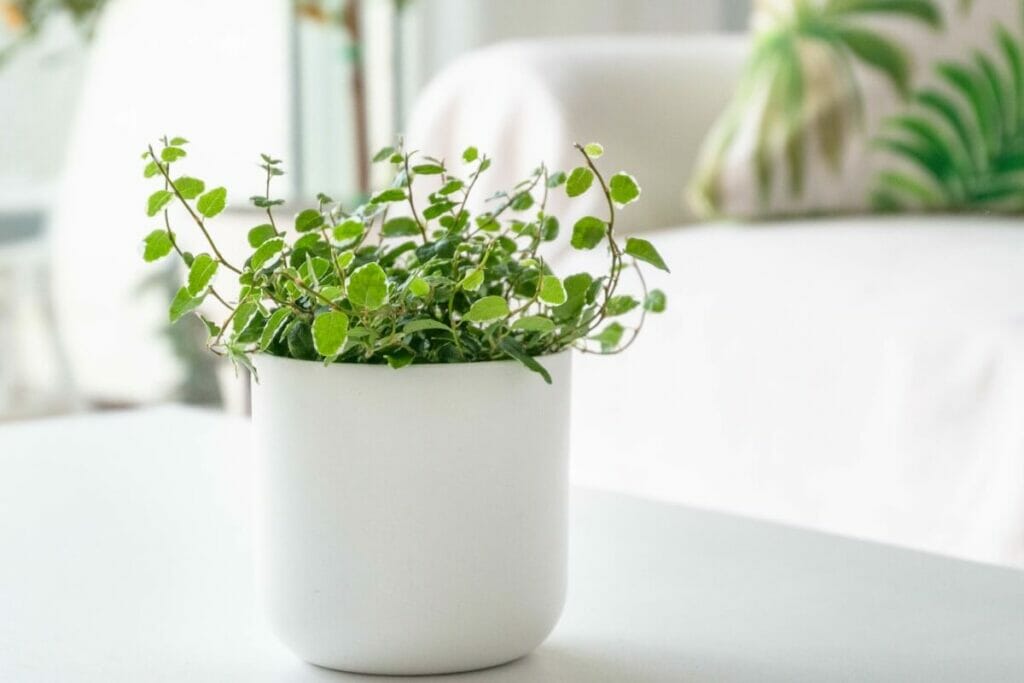
The creeping fig or climbing fig plant is a popular variety of ficus that grows natively in eastern Asia. As its common name suggests, this ficus is a vine with a creeping or climbing habit. As a result, you’ll need to support it so it can climb. While a creeping fig can cling to the walls of your home on its own, pulling it away can actually damage the paint on your walls.
| General Care | Easy to grow |
| Suitable for Indoors/Outdoors | Suitable for growing indoors. Hardy outdoors in USDA zones 7b-11 |
| Light | 6 to 8 hours of bright filtered sunlight and partial shade |
| Temperature and Humidity | 65-85°F and 50% of higher humidity |
| Watering | Prefers moist, well-draining soil. Water weekly |
| Growth Expectations | 1 to 2 feet per year up to 10 to 15 feet tall indoors |
| Toxicity | Toxic to pets and people |
3. African Fig Tree (Ficus cyathistipula)
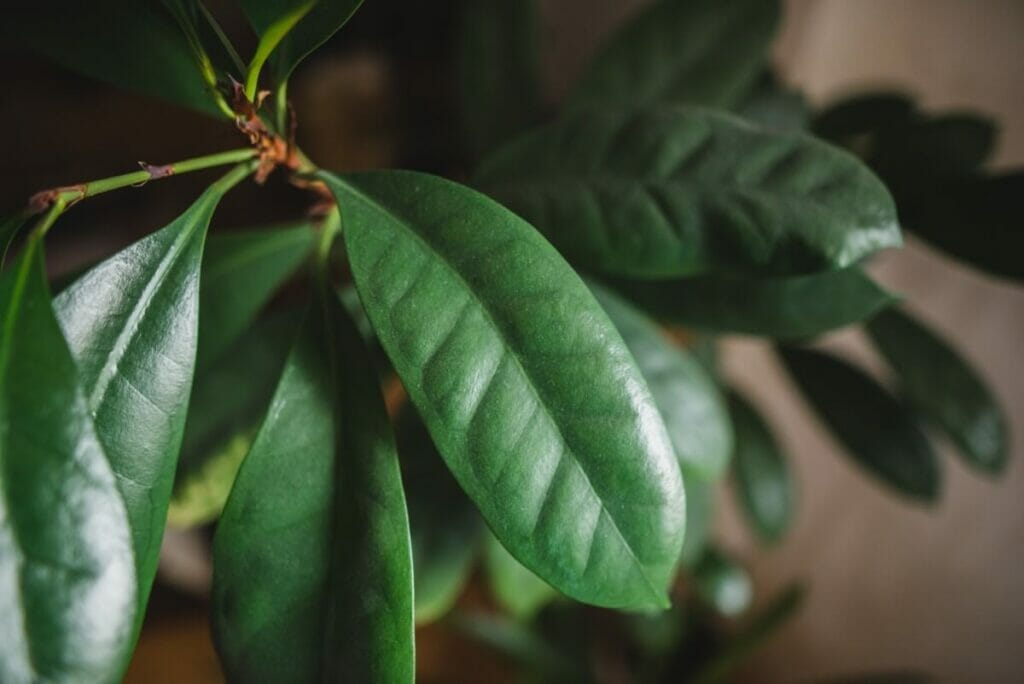
This ficus species can grow as small trees, shrubs, or hemiepiphytic lianas that cling to the sides of other trees in the tropical forests of Africa. Grown indoors, the African fig tree typically grows into a small tree with ovate leaves papering the plant’s slender trunk with large, lush foliage.
| General Care | Moderate Difficulty |
| Suitable for Indoors/Outdoors | Only suitable for indoor cultivation in most climates. Hardiness zone 13 |
| Light | Bright, filtered light |
| Temperature and Humidity | 65-75°F and 50% or higher humidity |
| Watering | Water with warm water twice a week |
| Growth Expectations | About 6 inches per year up to 2 to 6 feet tall |
| Toxicity | Toxic to people and pets |
4. Mistletoe Fig (Ficus deltoidea)
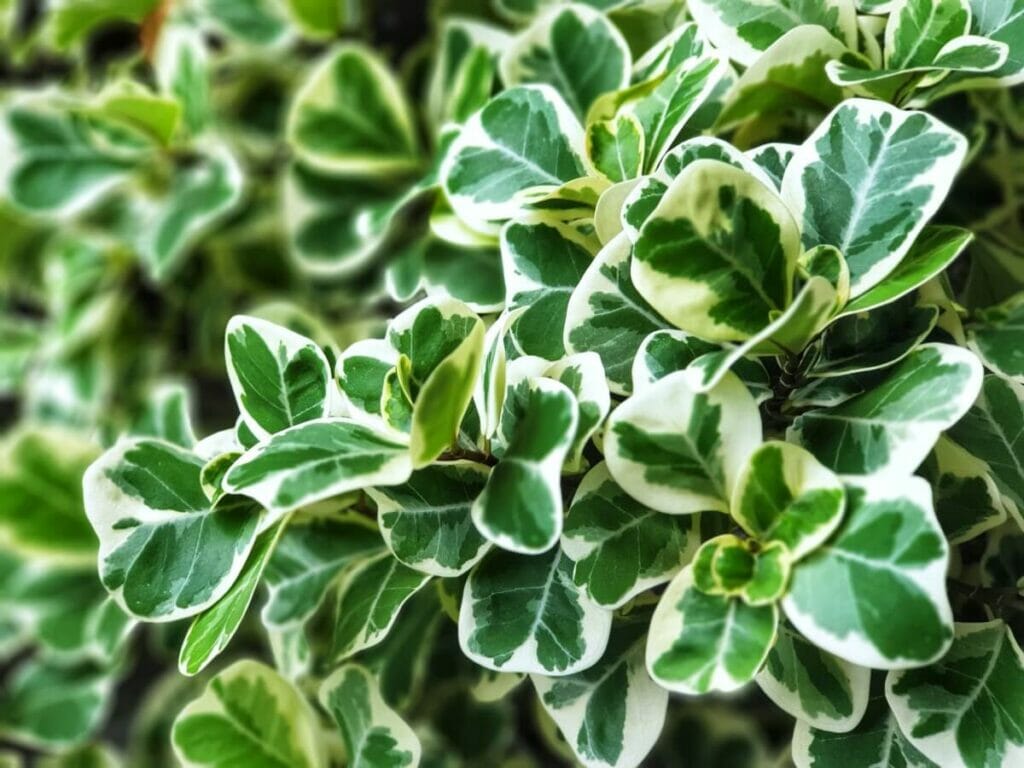
This species of ficus is native to southeast Asia. It features bright-green, rounded leaves and grows as a tree or hemiepiphytic shrub in its native climate. The mistletoe fig gets its name from the reddish-white berries the plant produces when it has ample sunshine. These berries result in the plant resembling the famous plant used for kissing at Christmastime.
| General Care | Moderate difficulty |
| Suitable for Indoors/Outdoors | Suitable for growing indoors. Hardy outdoors in zones 10b-11a |
| Light | Full sun, at least 6 hours of direct sunlight daily |
| Temperature and Humidity | Temperature above 55°F moderate to high humidity |
| Watering | Water every 7 to 10 days allowing the soil to dry between waterings. |
| Growth Expectations | Slow-growing up to 3 feet in a container |
| Toxicity | Toxic to people and pets |
5. Common Fig (Ficus carica)
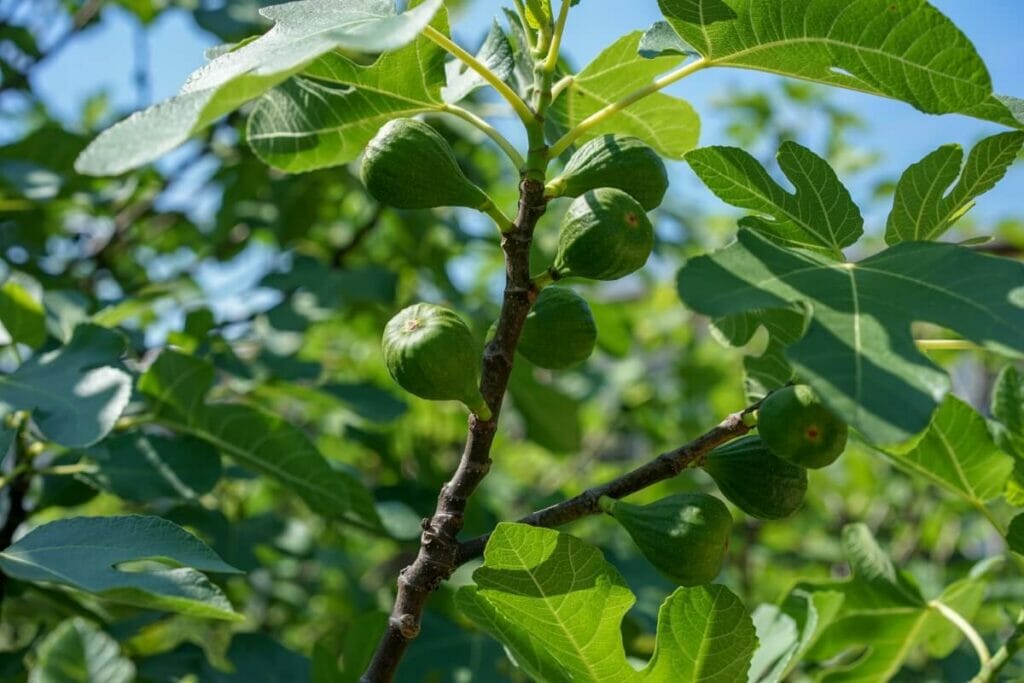
Native to western Asia, the Middle East, and the Mediterranean, the common fig is the species of fig you are likely most familiar with because this species of ficus tree produces the fruits we all know as “figs.” At some point, you have probably enjoyed these sweet fruits, which are often available dried, used in jams, or found in fig-based desserts.
| General Care | Moderately complex |
| Suitable for Indoors/Outdoors | Suitable for indoor growing and hardy outdoors in USDA zones 8-10 |
| Light | Full sun (at least 8 hours each day during the growing season) |
| Temperature and Humidity | 65-85°F and high humidity around 85% (misting is recommended) |
| Watering | Water every 1 to 2 weeks, allowing the soil to dry out between waterings |
| Growth Expectations | About 10 inches per year up to 3 feet indoors |
| Toxicity | The plant’s sap is toxic to people and pets. |
6. Red Leaf Fig (Ficus congesta)
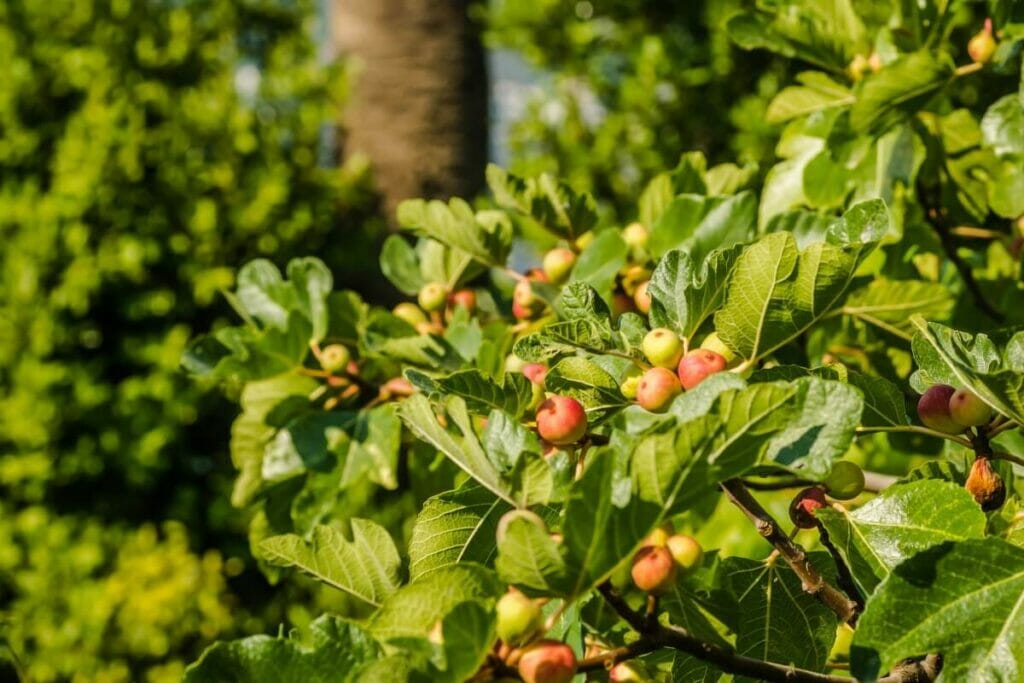
The red leaf fig is native to northeastern Australia, Indonesia, the Philippines, and Papuasia where it grows in rainforests, often along streams and creek beds. Mature leaves are vibrant green in color and long (about 5 to 10 inches), and they sprout from branches in alternate patterns that look like rosettes when viewed from above. New foliage growth has a reddish-orange, coppery coloring, and that’s where the Ficus congesta gets its common name.
| General Care | Moderately complex |
| Suitable for Indoors/Outdoors | Indoors and outdoor growing zone 12 |
| Light | Bright, filtered sunlight |
| Temperature and Humidity | 65-85°F and high humidity |
| Watering | Keep well-draining soil evenly moist with weekly watering |
| Growth Expectations | About 1 foot per year up to about 10 feet indoors |
| Toxicity | Toxic to people and pets |
7. Burgundy Rubber Tree (Ficus elastica ‘Burgundy’)
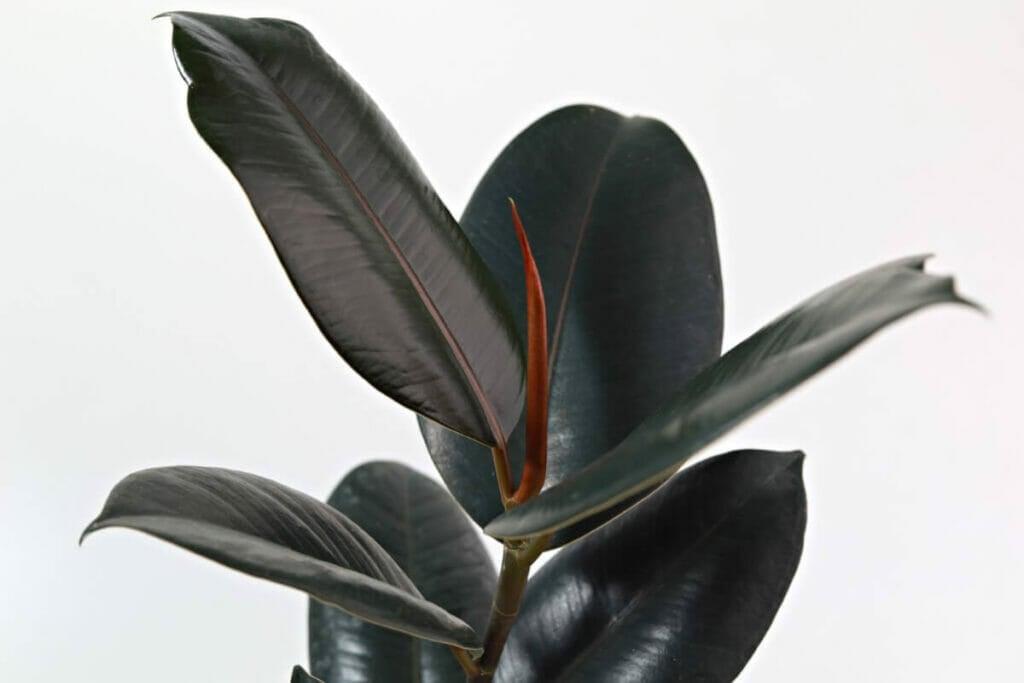
Native to the rainforests of South America and India, the burgundy rubber tree is a cultivar of the Ficus elastica. It features large, glossy, deep-green, ovate leaves that are each striped with a unique center vein in a strikingly bright red or burgundy color. This plant is relatively easy to grow, but it does not adapt well to change. So, be sure before you choose a location in your home.
| General Care | Low-maintenance and hardy |
| Suitable for Indoors/Outdoors | Grows well indoors. Outdoors in USDA hardiness zones 10 and 11 |
| Light | Bright, indirect/filtered sunlight |
| Temperature and Humidity | 65-78°F and high humidity (Leaf misting is recommended.) |
| Watering | Water when the soil is about 50-75% dry, about once every one to two weeks |
| Growth Expectations | About 6 inches a year up to 13 feet indoors |
| Toxicity | Toxic to pets and people |
8. Variegated Rubber Tree (Ficus elastica ‘Ruby’)
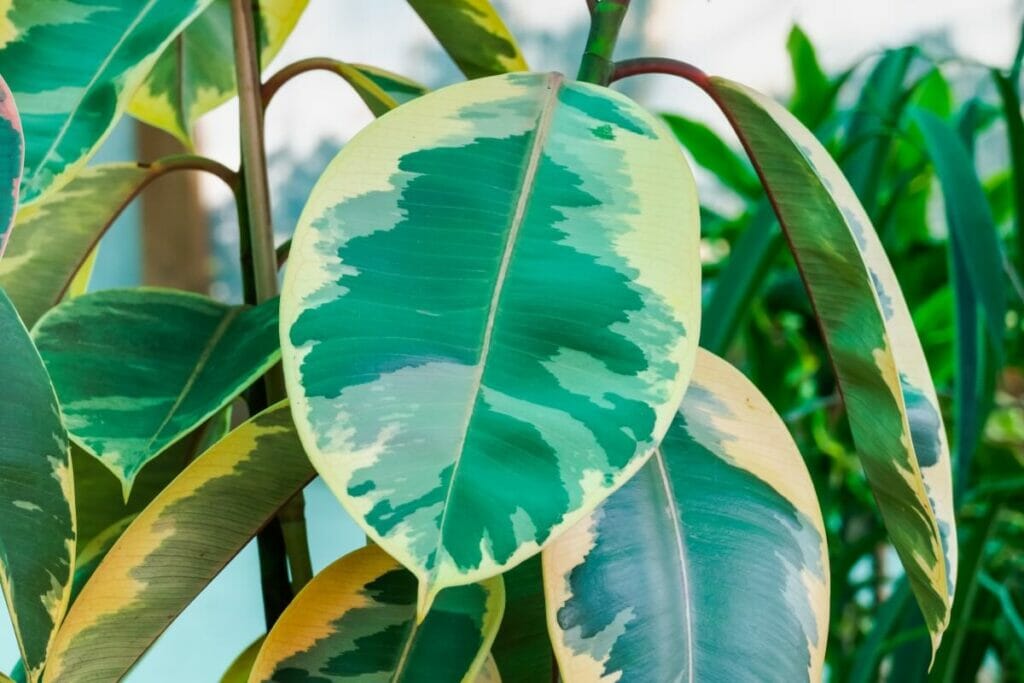
The variegated rubber tree or ruby rubber tree is one of the most striking ficus plants to grow at home. It features large, broad leaves that are splashed with cream, green, and a striking pink or red color. While this rubber tree is one of the most attractive, it does need more sunlight than other rubber trees because its less-green leaves do not photosynthesize as efficiently as their vibrant green counterparts.
| General Care | Easy to grow |
| Suitable for Indoors/Outdoors | Suitable for indoor growing. Hardy outdoors in zones 10 and 11 |
| Light | 6 to 8 hours of bright, filtered sunlight |
| Temperature and Humidity | 65-78°F and high humidity (Leaf misting is recommended.) |
| Watering | Water when the soil is about 50-75% dry, about once every one to two weeks |
| Growth Expectations | About 1 foot per year up to about 13 feet indoors |
| Toxicity | Toxic to people and pets |
9. Rubber Tree (Ficus elastica ‘Robusta’)
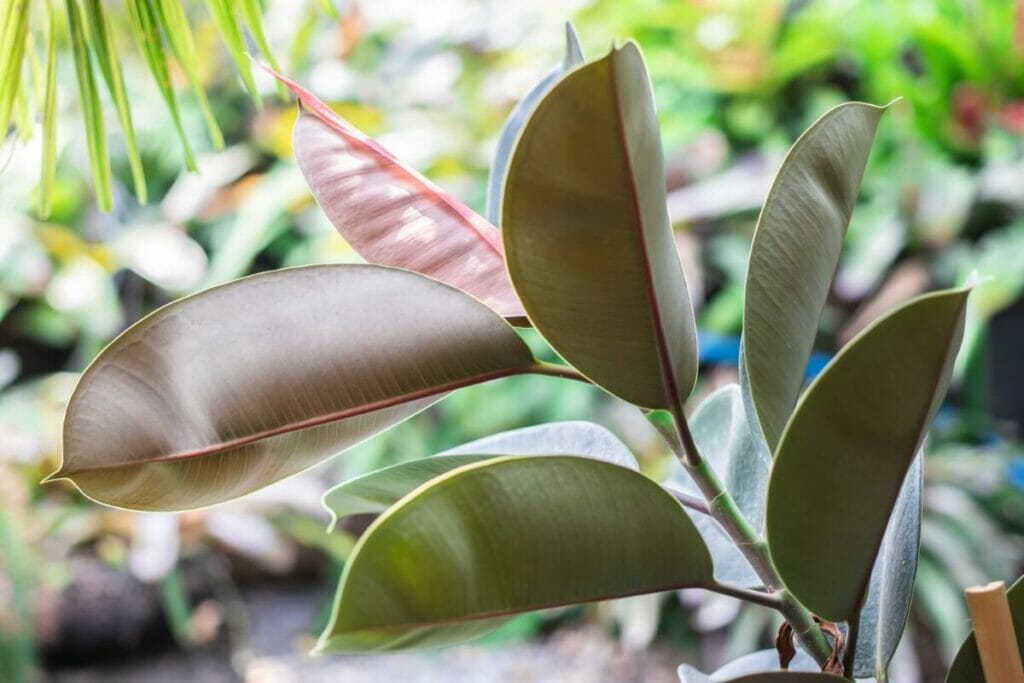
This cultivar of the Ficus elastica features a more compact silhouette and wider leaves, making it a great choice of houseplant thanks to its high-impact foliage and low-profile size. It’s also one of the easiest ficus trees to grow indoors in an artificial environment because it can tolerate the lower light conditions that are often common indoors while also handling the lower humidity that’s usually present inside.
| General Care | Easy to grow |
| Suitable for Indoors/Outdoors | Grows well indoors and is hardy outdoors in zones 10 and 11 |
| Light | Bright, indirect light. Can also tolerate lower light |
| Temperature and Humidity | 60-75°F and can tolerate average indoor humidity |
| Watering | Water when the top inch of soil has dried, about once a week. |
| Growth Expectations | About 12 inches per year up to 10 inches to nearly 7 feet in height (depending on the environment and care) |
| Toxicity | Toxic to pets and people |
10. Rubber Tree (Ficus elastica)
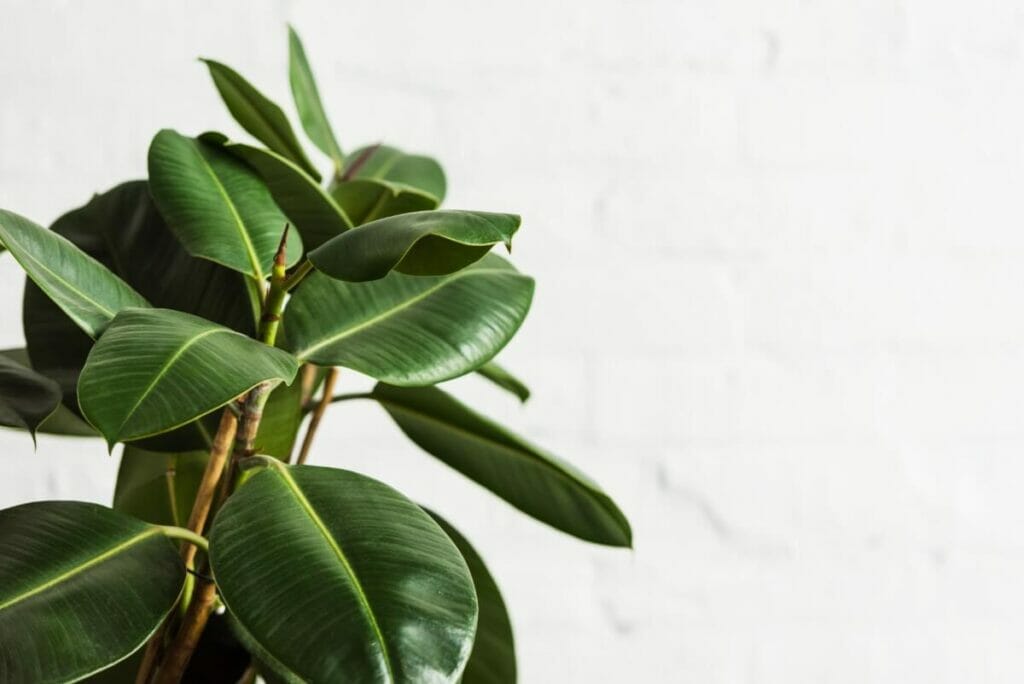
Although there are several cultivars of the Ficus elastica, this species, native to southeastern Asia, is the original rubber tree, and it’s one of the most popular houseplants. The rubber tree grows a slender, brown trunk from which large, broad, ovate leaves in a glossy green sprout in an alternating pattern around the stalk. In the wild, this ficus tree can reach almost 100 feet. Grown indoors, however, it’s much more manageable.
| General Care | Easy to grow |
| Suitable for Indoors/Outdoors | Great for indoors. Hardy outdoors in zones 10 and 11 |
| Light | Bright, indirect sunlight |
| Temperature and Humidity | 60-75°F and can tolerate average indoor humidity |
| Watering | Water when the top inch of soil has dried (about once a week) and allow all excess water to drain. |
| Growth Expectations | 12 to 24 inches per year up to about 10 feet |
| Toxicity | Toxic to pets and people |
11. Weeping Fig (Ficus benjamina)
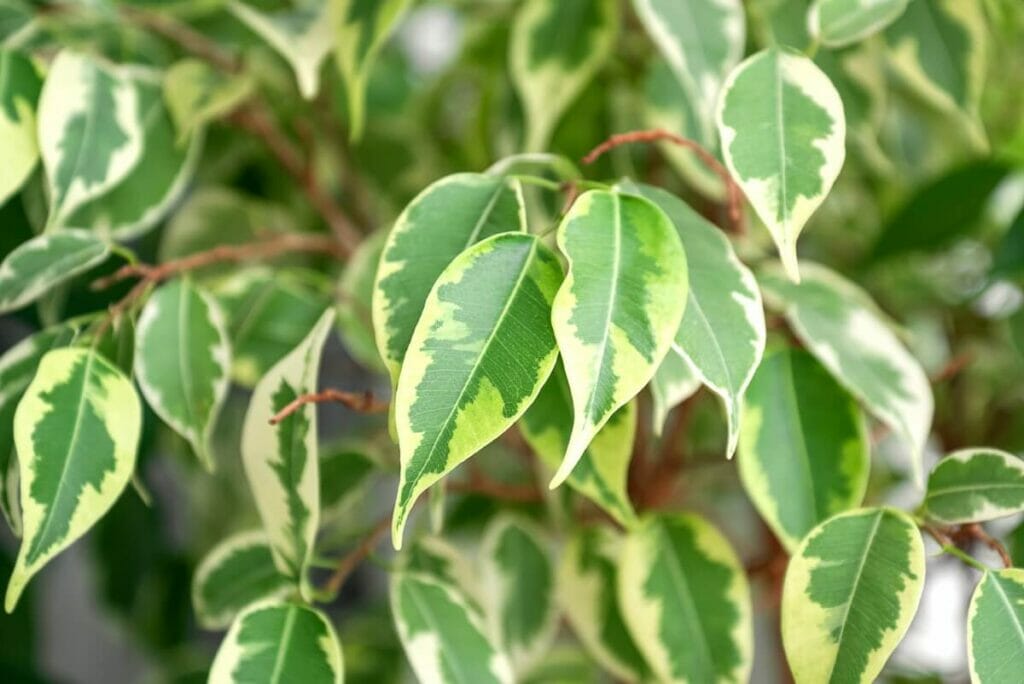
When you think of a basic ficus, the Ficus benjamina (commonly called weeping fig, Benjamin fig, or ficus tree) is most likely the plant you are picturing. These ficus trees are commonly trained to grow with braided stems or trunks and a prominent pom-pom-shaped burst of fluttery foliage at the top. The weeping fig is the official plant of Bangkok and a favorite in office spaces worldwide.
| General Care | Easy to grow |
| Suitable for Indoors/Outdoors | Perfect for growing indoors. Hardy outside in zones 10-12 |
| Light | At least 6 hours of filtered sun daily |
| Temperature and Humidity | 65-75°F and 60-80% humidity (misting is recommended) |
| Watering | Water about once a week, allowing the soil to dry in between |
| Growth Expectations | About 2 feet per year up to about 6 feet indoors |
| Toxicity | Toxic to people and pets |
12. Indian Banyan (Ficus benghalensis)
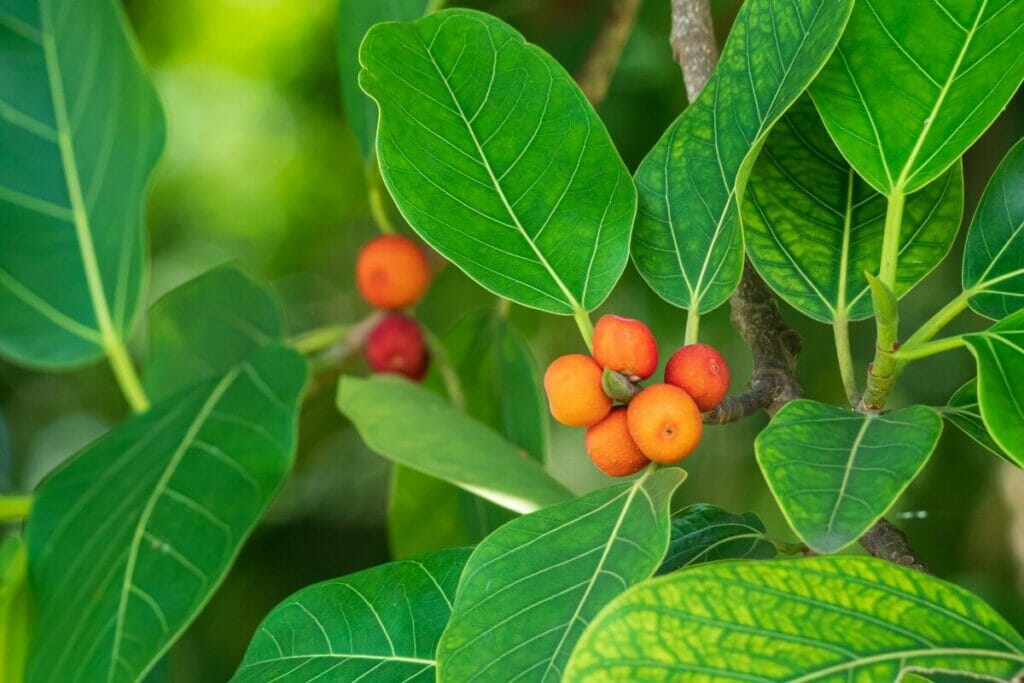
The Ficus benghalensis (aka Ficus Audrey) is native to India hence its common native the Indian banyan. Going by measurements of canopy coverage, several Indian banyans growing in Idia are classified as some of the largest trees in the world. Grown indoors, you can rest easy, knowing your banyan houseplant won’t achieve the same impressive size.
13. Chinese Banyan (Ficus microcarpa)
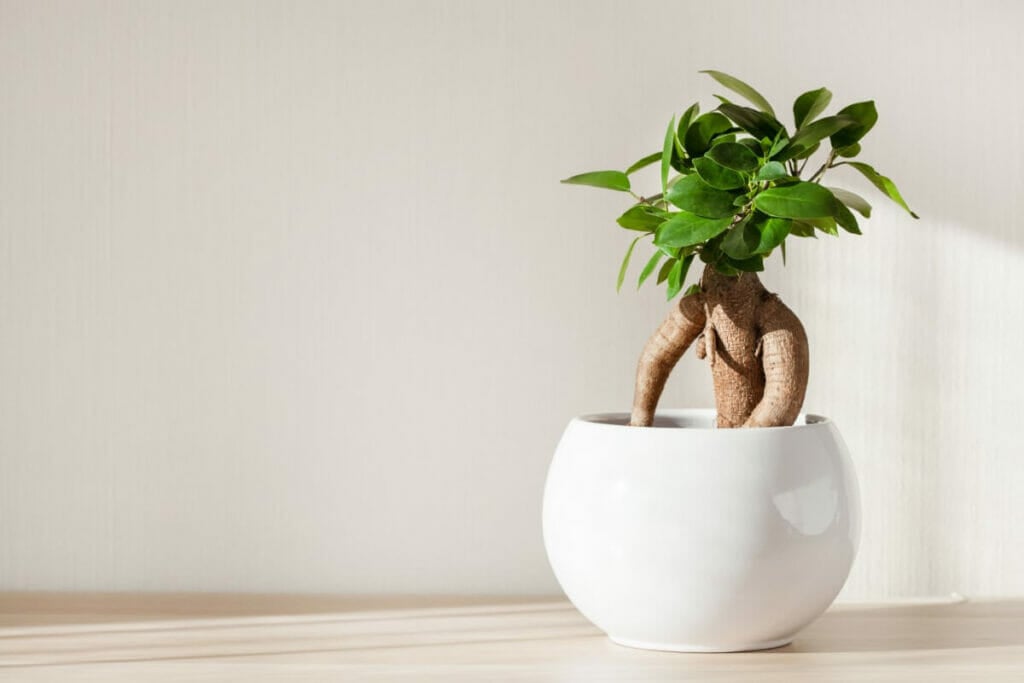
The Ficus microcarpa has common names including Chinese banyan, Malayan Banyan, Indian laurel, and curtain fig. Its native habitat spans the tropical regions of southeastern Asia and Australia. This tree species produce whitish-red berries and is often cultivated in miniature form as a bonsai tree.
| General Care | Easy to grow |
| Suitable for Indoors/Outdoors | Great for growing indoors. Hardy outdoors in zones 10-11 |
| Light | Bright, indirect sunlight (can tolerate some shade) |
| Temperature and Humidity | 60-70°F and high humidity (misting is recommended) |
| Watering | Water with filtered water once every two weeks or when the soil has dried out completely. |
| Growth Expectations | Slow-growing. Bonsai versions typically reach one to feet after a few years. |
| Toxicity | Toxic to pets and people |
14. Moreton Bay Fig (Ficus macrophylla)
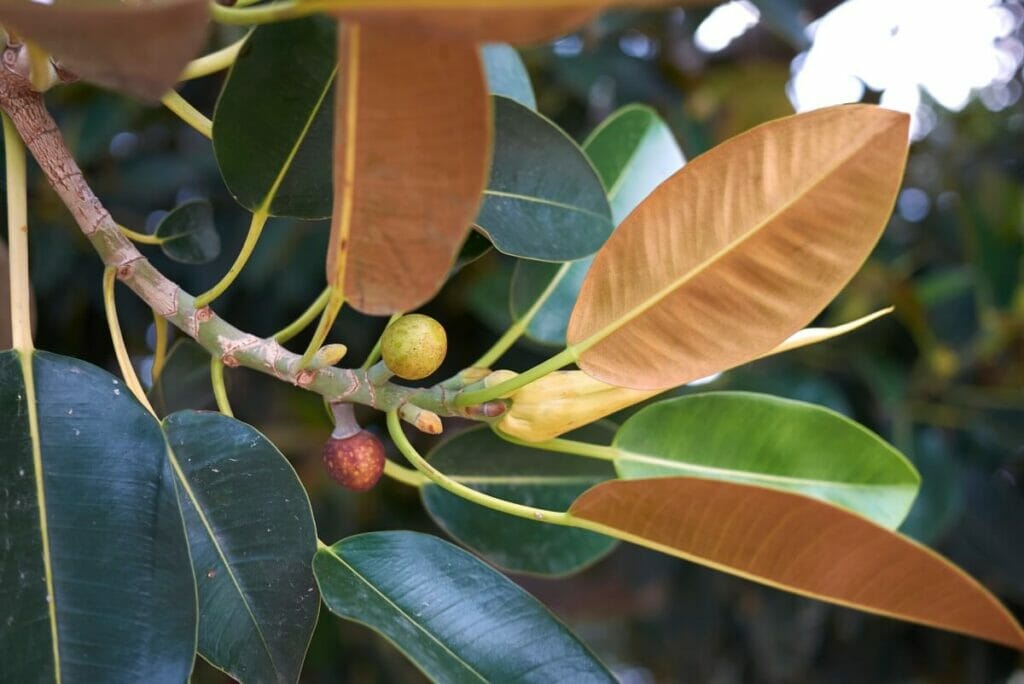
The Moreton Bay fig, large-leafed ficus, or Australian banyan grows as a large (almost 200 feet tall), evergreen tree in its native range in Australia. These ficus trees have large, showy root systems that protrude and survive above the ground, giving these trees a theatrical appearance in nature and when cultivated indoors.
| General Care | Difficult to grow |
| Suitable for Indoors/Outdoors | Suitable for growing indoors with a large enough container. Hardy outdoors in zones 9-11 |
| Light | Medium to bright, filtered sunlight |
| Temperature and Humidity | 68-86°F and moderate to high humidity |
| Watering | Water about once every two weeks when the soil has dried completely |
| Growth Expectations | Fast-growing when young up to about 5 to 10 feet, given enough space for the roots to spread |
| Toxicity | Toxic to people and pets |
15. Retusa Bonsai (Ficus retusa)
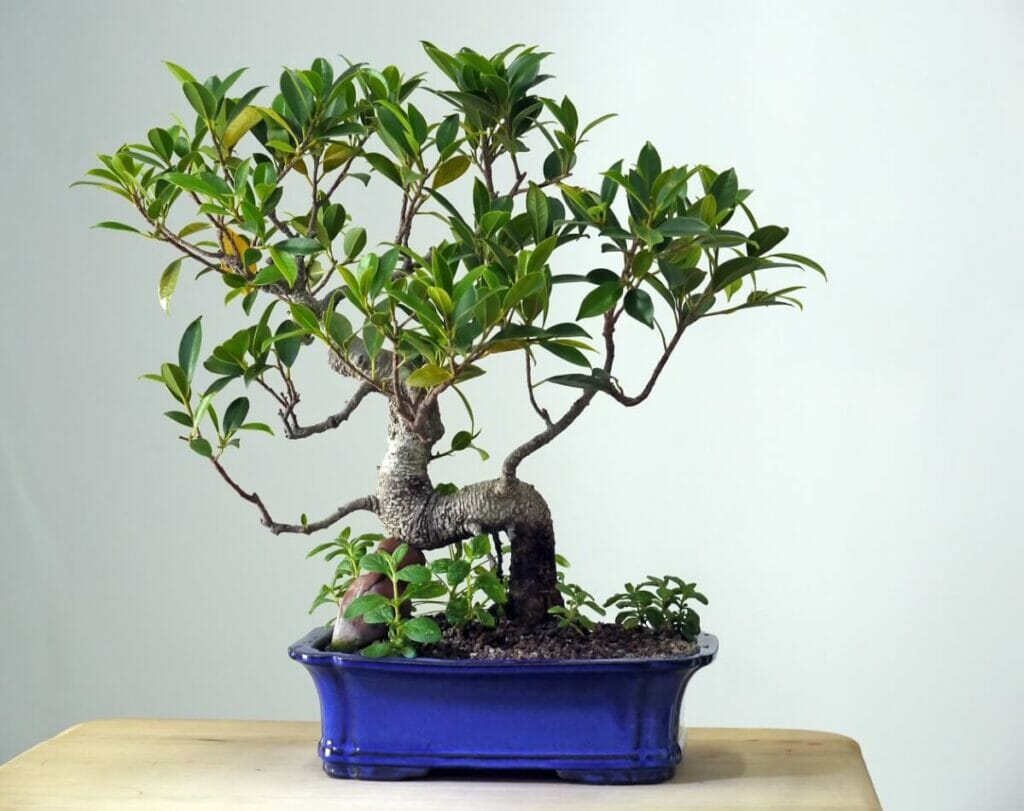
Native to the Malay archipelago, this ficus tree can grow to be just over 30 feet tall when growing in its natural habitat. However, the Ficus retusa is commonly called the retusa bonsai because it is most often cultivated indoors as a miniature bonsai tree.
| General Care | Easy to grow with a bit of pruning and maintenance required |
| Suitable for Indoors/Outdoors | Suitable for indoor growing. Hardy outdoors in zones 10b-11 |
| Light | 6 to 8 hours of bright, indirect light |
| Temperature and Humidity | 60-75°F and moderate to high humidity |
| Watering | Water every one to two weeks when the top 1 to 2 inches of soil is dry |
| Growth Expectations | Fast-growing up to about 2 feet as a bonsai |
| Toxicity | Toxic to people and pets |
16. Alii Fig (Ficus maclellandii)
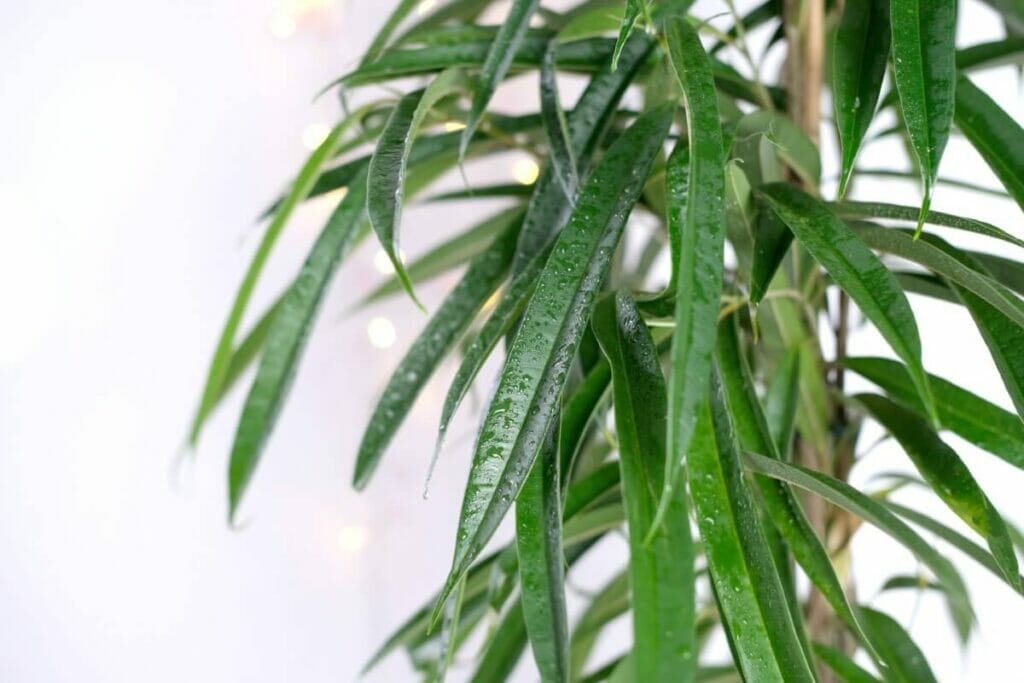
Native to India, China, and southeastern Asia, the Alii fig or banana-leaf fig produces two kinds of leaves – both long and narrow. Those growing near the top on higher branches are broader than the narrower leaves growing toward the plant’s base from branches closer to the ground.
| General Care | Easy to grow |
| Suitable for Indoors/Outdoors | Suitable for indoor growing. Hardy outdoors in zones 9-11 |
| Light | Bright, indirect light |
| Temperature and Humidity | 55-75°F and 40-50% humidity |
| Watering | Maintain evenly moist soil by watering as soon as the top 1 to 2 inches of soil is dry |
| Growth Expectations | Fast-growing up to about 10 feet |
| Toxicity | Toxic to people and pets |
17. Council Tree (Ficus altissima)
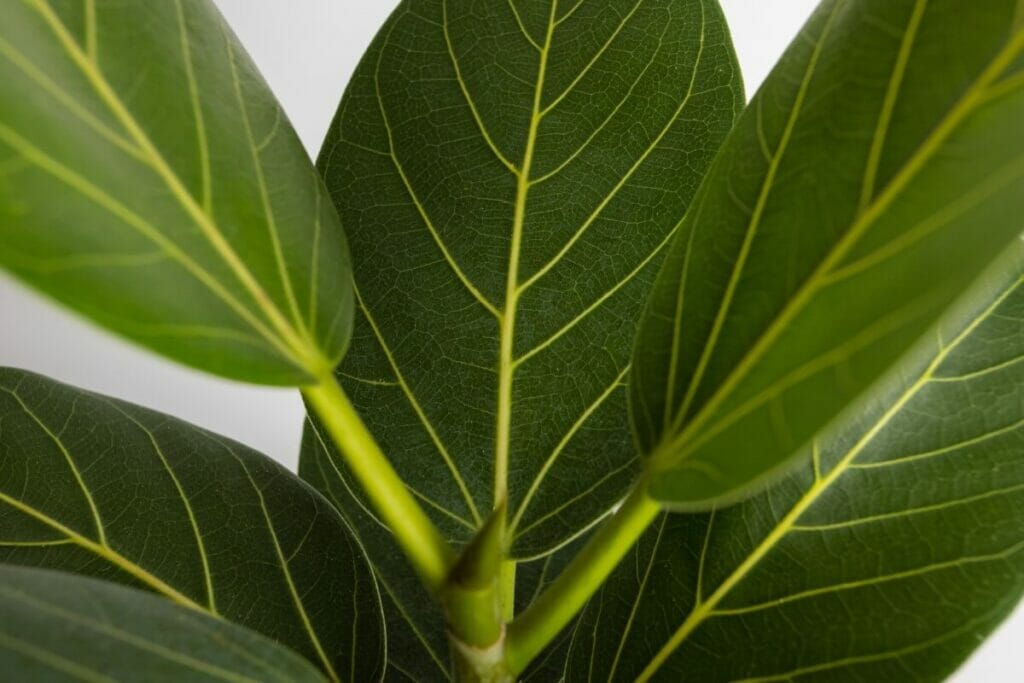
Commonly called the council tree or lofty fig, the ficus altissima is native to southeastern Asia and can reach heights of up to about 100 feet when growing in its natural habitat. It is an epiphytic ficus that grows by “strangling” or climbing up neighboring trees.
| General Care | Easy to grow |
| Suitable for Indoors/Outdoors | Suitable for indoors. Hardy outdoors in zones 10-12 |
| Light | Bright, indirect light |
| Temperature and Humidity | 60-80°F and moderate humidity |
| Watering | Water once every two weeks or when the soil has dried out completely. |
| Growth Expectations | Fast-growing up to about 6 to 10 feet indoors |
| Toxicity | Toxic to people and pets |
Grow the Right Ficus Tree for Your Home
No matter which ficus tree is your favorite, it is important to select a species that will grow well in your home’s environment. When selecting a type of ficus tree and location for it in your home, be sure to carefully consider the light conditions, temperature, and humidity in the plant’s specific spot. Taking care to provide your new ficus with the right environmental conditions will help ensure you enjoy a long, happy life with your houseplant.
